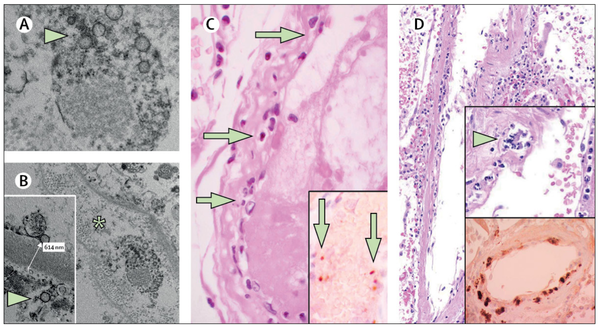(1st paragraph) Cardiovascular complications are rapidly emerging as a key threat in coronavirus disease 2019 (COVID-19) in addition to respiratory disease. The mechanisms underlying the disproportionate effect of severe acute respiratory syndrome coronavirus 2 (SARS-CoV-2) infection on patients with cardiovascular comorbidities, however, remain incompletely understood.
(4th paragraph) Post-mortem analysis of the transplanted kidney by electron microscopy revealed viral inclusion structures in endothelial cells (figure A, B). In histological analyses, we found an accumulation of inflammatory cells associated with endothelium, as well as apoptotic bodies, in the heart, the small bowel (figure C) and lung (figure D).
(9th paragraph, last paragraph) Our findings show the presence of viral elements within endothelial cells and an accumulation of inflammatory cells, with evidence of endothelial and inflammatory cell death. These findings suggest that SARS-CoV-2 infection facilitates the induction ofendotheliitis in several organs as a direct consequence of viral involvement (as noted with presence of viral bodies) and of the host inflammatory response. In addition, induction of apoptosis and pyroptosis might have an important role in endothelial cell injury in patients with COVID-19. COVID-19- endotheliitis could explain the systemic impaired microcirculatory function in different vascular beds and their clinical sequelae in patients with COVID-19. This hypothesis provides a rationale for therapies to stabilise the endothelium while tackling viral replication, particularly with anti-inflammatory anti-cytokine drugs, ACE inhibitors, and statins. This strategy could be particularly relevant for vulnerable patients with pre-existing endothelial dysfunction, which is associated with male sex, smoking, hypertension, diabetes, obesity, and established cardiovascular disease, all of which are associated with adverse outcomes in COVID-19.
COVID-19(新型コロナウィルス感染症)における内皮細胞感染と内皮の炎症。 (Lancet. 2020.04.20)
(第1段落) COVID-19(新型コロナウィルス感染症)では、呼吸器疾患に加えて、心血管合併症が急速に重要な脅威として浮上している。 しかし、重症急性呼吸器症候群コロナウイルス2(SARS-CoV-2)感染が心血管系合併症を持つ患者に不均衡な影響を与えるメカニズムは、まだ完全に理解されていない。

(画像出典 thelancet.com https://www.thelancet.com/action/showPdf?pii=S0140-6736%2820%2930937-5)
(第4段落)電子顕微鏡を用いた解剖所見では、移植腎に内皮細胞にウイルスを包んだ構造体が認められた(図A、B)。病理所見では、心臓、小腸(図C)、肺(図D)において、アポトーシス体と同様に内皮に関連した炎症性細胞の集積が見られた。
(第9段落)本研究では、内皮細胞内にウイルス体が存在し、炎症性細胞が集積し、内皮細胞および炎症性細胞が死滅していることが示された。これらの所見は、SARS-CoV-2の感染は、ウイルスの関与(ウイルス体の存在で示されるように)および宿主の炎症反応の直接的な結果として、いくつかの臓器における内皮の炎症の誘発を促進することを示唆している。さらに、アポトーシスおよびピロプトーシスの誘導は、COVID-19患者の内皮細胞傷害において重要な役割を果たしているかもしれない。COVID-19-内皮の炎症は、COVID-19患者における異なる血管床における全身的な微小循環機能の障害およびそれらの臨床的後遺症を説明し得る。この仮説は、ウイルスの複製に取り組む間、特に抗炎症性抗サイトカイン薬、ACE阻害薬、スタチンを用いて内皮を安定化させる治療法の根拠となる。この戦略は、男性、喫煙、高血圧、糖尿病、肥満、心血管系疾患およびCOVID-19の有害な転帰と関連する全ての既往と関連する内皮機能障害を有する脆弱な患者に特に関係する可能性がある。
https://www.ncbi.nlm.nih.gov/pubmed/32325026
(千葉大学大学院医学研究院 救急集中治療医学 中田孝明 コメント)
心臓、小腸、肺の内皮細胞内にウイルス体が存在し、そこに炎症性細胞が集積し、内皮細胞・炎症性細胞がアポトーシス(細胞死)を起こしていることを示している。また、この病態に対して効果を発揮する治療法が検証すべき次の仮説として挙げられており、今後の重要な研究課題を示す興味深い論文である。ぜひ興味がある方は原文をチェックしてください。